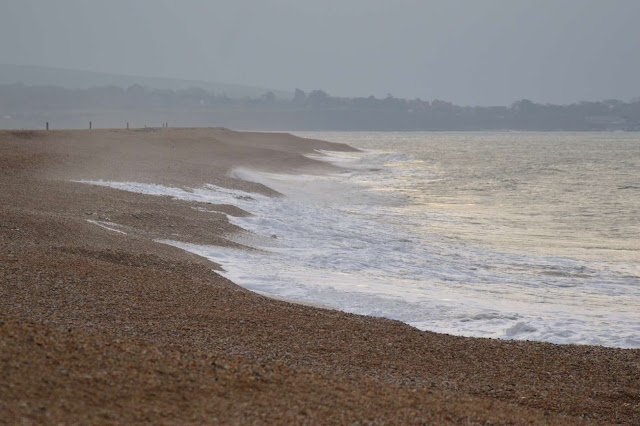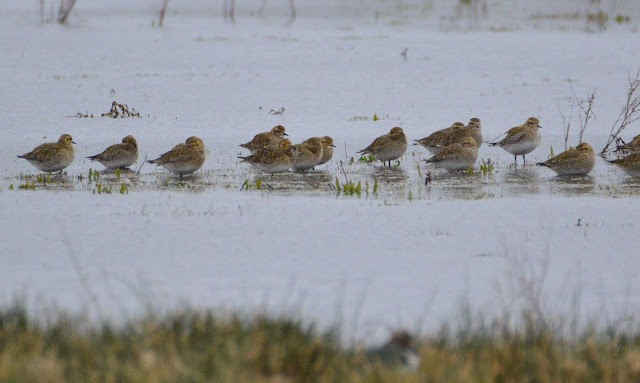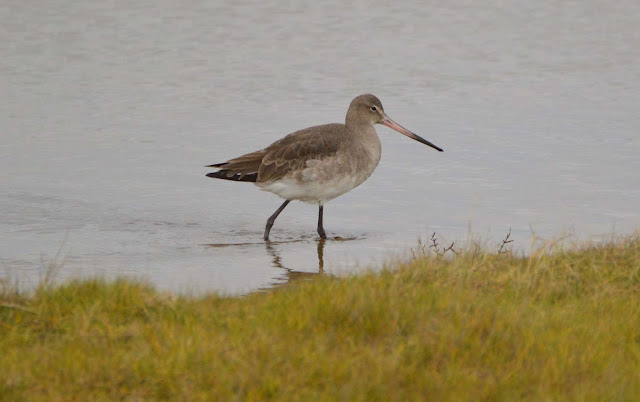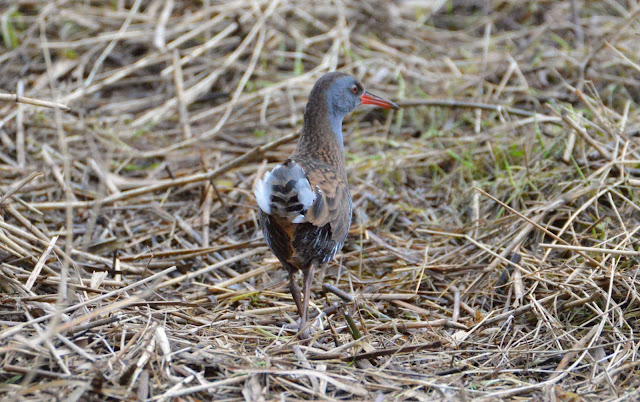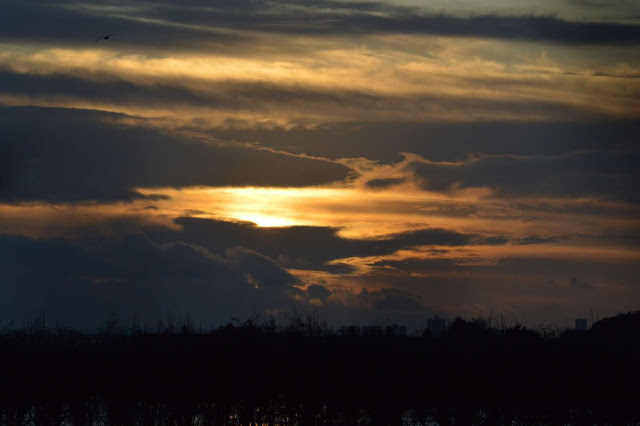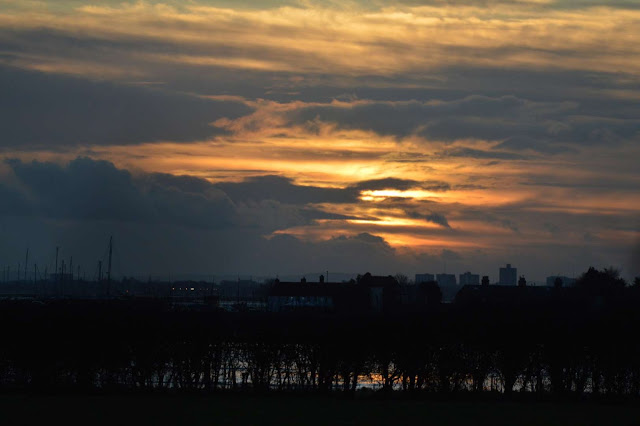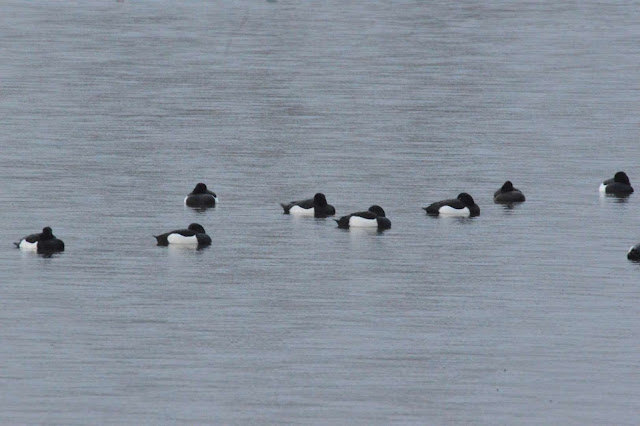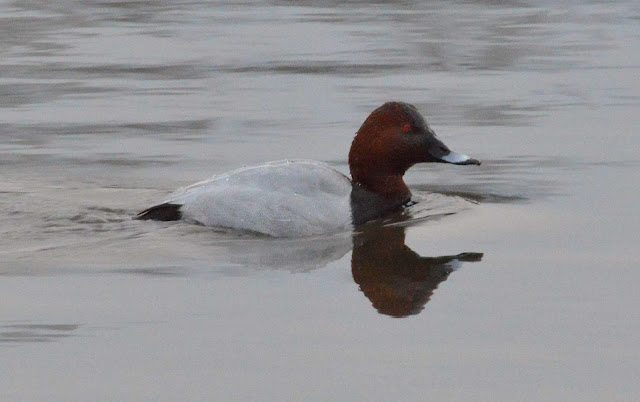Hurst Spit : A 1.5 mile massive shingle peninsular culminating in the famous castle built to protect the Western approaches of the Solent in 1544 by Henry VIII which sits three quarters of a mile from The Isle of Wight, the closest point to the mainland.
An impressive and imposing natural barrier that has been modified several times by the hand of man. Most recently in 1996 due to damage from severe storms in previous years creating fears of a breach that would endanger the ecological areas of Keyhaven and Pennington to the East and create serious flooding inland.
Today was a relatively calm one, but a stiff westerly breeze coming in through the gap by the famous Needles rocks from the English Channel, coupled with a high tide, creates enormous power as the water swirls and churns and is forced through the narrow gap between the spit and the island.
The power of the waves gives a renewed respect for the sea.
I have sailed through this channel in a force 7 on my first experience of handling a yacht and it really is squeeky bum time, especially for a novice like myself. I was steering while the rest of the crew sat on the edge of the boat to counteract the instability. Needless to say I haven't repeated this foolhardy act. Give me terra firma any day. I'm more than happy to observe from the shore.
I met Chris here just before dawn. It was still dark as I rolled up behind his car in the layby near the shore.
Our intention before walking Eastwards, was to spend an hour or so looking for sea birds in the bay off Milford shelter. These conditions can throw up some interesting sights.
The swell made it quite difficult to obtain decent views of anything on the surface however and the poor visibility didn't inspire to see much flying either, but we stuck at it while being buffeted by a cool brisk southerly.
Caffeine isn't always necessary whilst sitting on a beach at the beginning of January on the south coast of England what with the conditions, but it helps.... It's still a lot milder than 20 years ago though , that's a certainty.
We did manage distant views of Guillemots, Red Throated Divers and Bar Tailed Godwits as we caught up on life after the Christmas break, so it wasn't too bad.
With fingers growing numb and good intentions not too far behind, we headed for the respite the eastern side of the spit afforded us and drove the half mile along the shore to the calmer waters of Keyhaven Harbour, our starting point for our first joint walk of the year.
Although I was here a week previously, I am always more than happy to spend time in this wonderful coastal habitat.
The hope of brighter weather was literally just that. Apart from one or two threatening moments of Sun, it was going to be a predominately grey day.
Our cameras stayed slung at our sides all the way up to Pennington car park - our usual parking spot.
The floods by the old tip like last week and at this time of year are a great place to see feeding or roosting waders and ducks.
Golden Plover love this spot and didn't disappoint us either. Spread across the field in numbers of several hundred.
Far less numerous are Ruff. Spectacular looking in their Summer plumage, we only get to see them here in their rather drab winter attire. A rare but special bird nonetheless. There were at least three feeding in the flooded field.
Black Tailed Godwit congregate in numbers quite often too. I love their constant chattering to each other as they feed and bicker. As gregarious as they are, there is only so close they like to get to their neighbours before the long bill is used for more than feeding.
Our normal route takes in the sea wall but today we fancied the inland route through woodland and fields that take us around to Moses Dock. This route cuts across diagonally and saves a longer journey.
Past the lock it was round to the boating lake opposite Oxey Bay. A good sheltering place from the harshness the prevailing westerly often provides. As ever on the lake, several Little Grebe fed along with diving Tufted Ducks. A Greenshank roosted on the edge of island just like last week too.
The path winds round the edge of the bay by the boating lake and begins to scout the westerly tip of Normandy Marsh which from my previous blog, you will know can throw up some real gems on it's wide area bordered by ditches, very often frequented by Kingfishers and can throw up some lovely views.
The side of the path that edges the marsh is dotted with thick gorse and bramble as it reaches the foot of the scrapes. There is a lower path here but it tends to frighten the birds so we stick to the higher track. Better chances to see the fishing master from higher anyway.
We turned the corner heading West now. The breeze off the Solent was stiffening, naturally, on this exposed promontory.
We both spotted a familiar sight. A specialty here and a success story - flying in the face of current avian trends - the Dartford Warbler. It is a sedentary little cracker and a favourite of ours. It allows the odd occasional view, never too much, quite often too little, which keeps us hankering for more.
Today though, albeit limiting in numbers and visibility, was proving to be one of individuals affording us some real intimate moments.
The warbler seemed unconcerned before us, clearly used to the regular footfall of humans, cycles and dogs.
It has a lovely lazy undulating flight as it flits from gorse to gorse, using it's tail like a swish of an artists paintbrush painting wispy invisible sky patterns.
It was happy enough to sit and preen with us some ten feet away too.
We carried on along the long Eastern path. A shout from Chris alerted me to another favourite.
It was distant but if we were careful we could sneak up as The King was concentrating on the fish filled ditch below.
We were close by and about to get some cracking views when a stray dog frightened our subject off. A cry of 'Bloody dogs!' went up, although the young owner took umbrage to this. This is a place for everyone, but dogs are requested to be under control on nature reserves and quite frequently they are not. I have put this politely to dog owners before and have received abuse on every occasion. 'They've got wings, they'll fly back ' was my last response. Birds are very sensitive to disturbance. Either breeding in spring when they can easily desert a nest or in winter when feeding in short daylight hours. They may have travelled far and by losing weight, will need to re stock their fat and energy supplies. Or by constant interruptions, it can affect their feeding patterns, especially when a short tidal window is available.
Thankfully, our aqua marine missile wasn't to be put off on this occasion. In fact it was as amenable as the warbler.
A couple of hundred shots later, exchanged glances of awe between myself , Chris and the subject, we walked away glowing after a visual form of central heating.
I'll let the photos speak....
Our route back was definitely going to be the sea wall after such delights. We walked with the glow of the boy from the Ready Brek advert after that excitement.
Normandy Marsh had plenty of things to see on the scrapes although our attention had been diverted.
Black Tailed Godwit once more and the delicate form of 16 Avocet roosting out of the harsh wind.
Once reaching the most southerly point of the seawall, it's a constant decision of looking into the Solent or the lagoons. The sea being still choppy, failed to push the elusive Red Necked Grebe into view that had been ever present in the last month and I had failed dismally to see last week. Red Breasted Merganser were happy to pose in the lagoons however. Both male and female.
There's always a Tufted Duck in the vicinity to help placate ones photographic thirst too. A childhood favourite, I used to watch these, along with Great Crested Grebes on the old gravel pits of Laleham when I was a kid.
Having reached the Pennington car park path, some birds were starting to feed on the receding tide. Grey Plover...
..and a Bar Tailed Godwit, The Black Tailed's rarer and slightly smaller cousin. It takes a keen eye to decipher them from their larger and more gregarious opposite number.
Greenshank too. Very nervous beings. This one flew off, only to run rapidly back to the place of it's origin in front of us on the shore.
Upon reaching Keyhaven Harbour once more, the tide was at a low ebb. Black Tailed Godwit had accumulated in large numbers at the harbour mouth on the exposed mud.
On the opposite side of the bridge sits the river that flows into the harbour. On the other side of this are former arable fields once drained but now given back to nature. There is a small hide here and for an annual fee the local nature reserve - run by volunteers - will let you in for a view up the reed fringed wetland. The hide is a former water works pump house. Quite small but very exclusive and welcoming. They have provided feeders for the wild birds just outside and the views across the scrape are very good. Thankfully Chris had obtained permission to enter with his key...thanks Chris, I owe you one..or two by now..!
There isn't a huge amount of activity but what there is commands the attention.
Immediately our friend was back. In fact there were at least two around.
Any perch will do, regardless of it's strength. Reeds are very ubiquitous and adaptable here.
The reed bends and sways but the Kingfisher's head stays fixed, immovable. Scientifically it is known as optical reflex.
Ravens appeared overhead. Marsh Harriers are seen every day but not in the half hour we were there though.
Another chap had entered the hide and spoke of the elusive and rarely photographed Water Rail that feeds on the spilt seed from the bird feeders. We didn't have to wait for long. This is such a common bird around wetland areas. Often heard giving their impression of a stuck pig, it makes you wonder how such a beautifully shy bird can make such a God awful sound.
The local and more apparent Egret was equally beautiful, giving superb reflections in the calm reed reflected bay.
The Water Rail usually keeps hidden amongst the vast maze of reed forest so we were honoured in it's calmness before us. There were at least three here, if not a fourth.
A day limited by the weather conditions and number of sightings but proving that less can really prove to be more.
That was the Saturday. The following Friday I was presented with a conundrum. I had finished a job a day earlier than expected. I could easily have filled it with work once more but my current train of thought is to grab life and enjoy time out when you can, for those are the days we will remember the most.
It didn't stop me from titivating around before I had the chance to go walking but at least I had a Friday afternoon to enjoy.
My destination was a place called Southmoors. A northern shore on Langstone Harbour next to Hayling Island. It provides great views into the harbour towards Portsmouth and our usual haunt of Farlington Marshes.
I walked the sea wall for a while. There were several Goldeneye Duck feeding offshore and at least 32 Red Breasted Merganser roosting in the calm waters of the bay next to the bridge that links Hayling to the mainland.
After an hour I had swapped shore and decided on the oyster beds, just over the bridge on Hayling itself.
Out on the sea 3 Slavonian Grebes were feeding. Diving into the choppy water.
I walked to the calmer bay of the beds where the roosting waders had departed. Clearly frightened off by some predator.
Still a few Curlew fed unperturbed. Some Red Breasted Merganser too.
In the flooded field by the Hayling Billy path there was an indolent Greenshank also.
It was quiet apart from that so I took off in the direction of the old village of Warblington as the sun was setting.
Next to the old church and the farm a rare Cattle Egret had been feeding in the fields, associating itself with it's namesake.
It was still to be seen, along with several Little Egret.
The light was fading but the sunset gave a warm glow to the scene as Brent Geese flew in from the adjacent marsh to graze in the fields nearby.
I stood in the cemetery sneaking a peak through the trees and shrubs separating it from the cow field trying not to disturb the Egrets.
I was once told how to call cows by a work colleague which has worked on numerous occasions. They sometimes come trotting over. So I thought I might try it this time to bring the Cattle Egret closer. The cow just looked at me with a quizzical eye and kept on grazing. Oh well, nothing ventured...
The difference between the Little and Cattle Egret is quite obvious here. The Cattle Egret on the left with a slightly shorter yellow bill. Little Egrets has a longer darker one with dark legs and yellow feet on the adults. Little's are usually seen in areas of marsh, rivers, estuaries, shoreline etc. Where there are Cattle, you will find the Cattle Egret on almost all occasions.
A short and sweet Friday afternoon. I had Saturday to look forward to as well...
I had arranged Saturday for my second walk and talk with Jonathon. I had been asked last spring to present a walk around a nature reserve for the local hospital radio in Southampton. The programme is also aired for the partially sighted in the Southampton area and is played on a loop for a couple of months. Jonathon is a presenter on the programmes and has a passion for music too so we have common ground.
This was the winter version and I had decided that Lower Test Nature Reserve in Totton might be the perfect spot to take people for a wander into the natural world on their patch.
The Test River spills into the very top of Southampton Water, which in turn empties some ten miles later into the Solent. Southampton Water is known as a Ria, or a flooded valley of the Solent and is formed by the rivers that flow into it. The Itchen, Hamble and Test which lies at the very North end.
The source of the Test is around Ashe near Basingstoke and travels it's circuitous route some 30 miles South.
As the Test funnels to it's demise, it is bordered by industrial and housing estates, creating a huge conflict between the natural and unnatural worlds. It's a fine line but a balance is struck, just about. The more we push, the closer it gets to the point of no return and here is a place that creates a visual realisation of that fact.
The weather was damp, grey and mild. The visibility was poor but it gave an eerie atmosphere in keeping with the area.
Jonathon and I started at the bridge near The Salmon Leap pub. We cut across to the path that follows the line of pylons on the West side of the valley. The cranes at the Prince of Wales container port in Southampton stood shrouded in mist like metal dinosaurs. They were still, no ships to unload.
The pylons straddle the area like giants, dwarfing the reed beds below. Starlings use them as staging posts on their way to roost. Peregrines use them as vantage points to catch the Starlings.
Jonathon and I circumnavigated the reserve as I garbled into the microphone explaining the sights before me.
There wasn't too much about unusually, especially as it was low tide by the two bridges that sit between the Test and Southampton Water, straddled by the A35.
On the Eastern side across the bridge, the railway edges the reserve and you have to cross the tracks back onto the boardwalk of the reserve.
As we headed back to the bridge to our destination and place or origin, the tide was beginning to rise. A distant Peregrine flitted around a pylon and flew off.
Back at the bridge, the water had risen enough to entice a male Goosander into view which made a perfect end to my walk and talk. The sawbill member of the duck family. It has the most iridescent head with a hooked tip to the bill that makes the perfect tool for catching fish.
The still conditions gave great reflections in the river from the power lines above.
Jonathon had left after my walk and talk so I decided on a quick walk further into the reserve.
There is a hide here overlooking the scrapes and pools in the valley. It has been adapted from a container from the nearby container terminal. The irony wasn't lost on me in the current area.
A Firecrest flitted past me as I sat in the metal cage. One of the smallest birds in this country and quite a rare sight in this area.
Outside along the boardwalk there were Water Pipits feeding in the boggy marsh. It's cousin, the Meadow Pipit was more disposed for a photograph however.
There are two parts to this reserve. It has a long spread up the valley and at the very northern part is Testwood Lakes. These are old gravel pits separated into four lakes. The main 2 at the top end are given soley over to nature. The other two are predominately used for sailing and fishing. These are managed by The Hampshire and Isle of Wight Wildlife Trust or HIOWWT. The 'Trusts' are country and county wide. They do great things locally in the British Isles and are well worth supporting.
My walk began from the visitor centre. The path that leads to two hides on the lakes are dotted with Hazel Catkins, perhaps one of the earliest harbingers of Spring? There have been many sightings of Hawfinch here, not least our own but today they remained out of sight as I trudged towards the first hide, which proved good timing as the rain began to fall with determination now.
Meadow lake was very quiet apart from a very vocal Egyptian Goose that announced it's departure at length. My camera was wrapped in it's rain cover so I was too slow to extricate it from it's lair to grab a shot of the departing bird.
Egyptian Geese are native to the Southern Sahara and the Nile Valley and were introduced into this country by escapees from private collections. I remember seeing a male and female with 3 chicks on a tributary off the Dartmouth River at Tuckenhay in Devon a few years ago.
The last hide at the end lake usually gives some better views. The reed fringed edge is frequented by Bitterns. These camouflaged indolent individuals are part of the Heron family but are the most secretive. You need a keen eye and bucket loads of patience to see one unless you are very lucky.
One of my first sightings was of a group of Shoveler ducks doing an impression of 'Ring a ring o roses' They keep circling with seemingly no end in shape or time.
I have seen this here once before. All I can imagine is a way of feeding that corals the invertebrates on the surface like dolphins accomplish in a baitball of herring?
A few male Pochard were here too. Recently added to the red list...i.e. they are now considered critically endangered in this country. Once a common diving duck seen here in winter and breeding in more Northern altitudes, there are seen less frequently nowadays.
There were many Tufted Duck here too. They had been feeding earlier no doubt as they had barely moved all the time I was here.
This is a strangely quiet reserve. It should give off more than it does.
Cormorants a a constant here along with most other places.
So are Coots...
The sun was setting, not that you could see much of that. The lack of light gave the game away.
A Lapwing flypast sent me on my way along the boardwalk back to the van.
A week of three walks, set in a monochrome world. Yet in all three there were shafts of light when all around was dark.
The title of this post is a line taken from the poem 'A Grey Winter's Day' by Phil Soar.
An impressive and imposing natural barrier that has been modified several times by the hand of man. Most recently in 1996 due to damage from severe storms in previous years creating fears of a breach that would endanger the ecological areas of Keyhaven and Pennington to the East and create serious flooding inland.
Today was a relatively calm one, but a stiff westerly breeze coming in through the gap by the famous Needles rocks from the English Channel, coupled with a high tide, creates enormous power as the water swirls and churns and is forced through the narrow gap between the spit and the island.
The power of the waves gives a renewed respect for the sea.
I have sailed through this channel in a force 7 on my first experience of handling a yacht and it really is squeeky bum time, especially for a novice like myself. I was steering while the rest of the crew sat on the edge of the boat to counteract the instability. Needless to say I haven't repeated this foolhardy act. Give me terra firma any day. I'm more than happy to observe from the shore.
I met Chris here just before dawn. It was still dark as I rolled up behind his car in the layby near the shore.
Our intention before walking Eastwards, was to spend an hour or so looking for sea birds in the bay off Milford shelter. These conditions can throw up some interesting sights.
The swell made it quite difficult to obtain decent views of anything on the surface however and the poor visibility didn't inspire to see much flying either, but we stuck at it while being buffeted by a cool brisk southerly.
Caffeine isn't always necessary whilst sitting on a beach at the beginning of January on the south coast of England what with the conditions, but it helps.... It's still a lot milder than 20 years ago though , that's a certainty.
We did manage distant views of Guillemots, Red Throated Divers and Bar Tailed Godwits as we caught up on life after the Christmas break, so it wasn't too bad.
With fingers growing numb and good intentions not too far behind, we headed for the respite the eastern side of the spit afforded us and drove the half mile along the shore to the calmer waters of Keyhaven Harbour, our starting point for our first joint walk of the year.
Although I was here a week previously, I am always more than happy to spend time in this wonderful coastal habitat.
The hope of brighter weather was literally just that. Apart from one or two threatening moments of Sun, it was going to be a predominately grey day.
Our cameras stayed slung at our sides all the way up to Pennington car park - our usual parking spot.
The floods by the old tip like last week and at this time of year are a great place to see feeding or roosting waders and ducks.
Golden Plover love this spot and didn't disappoint us either. Spread across the field in numbers of several hundred.
Far less numerous are Ruff. Spectacular looking in their Summer plumage, we only get to see them here in their rather drab winter attire. A rare but special bird nonetheless. There were at least three feeding in the flooded field.
Black Tailed Godwit congregate in numbers quite often too. I love their constant chattering to each other as they feed and bicker. As gregarious as they are, there is only so close they like to get to their neighbours before the long bill is used for more than feeding.
Our normal route takes in the sea wall but today we fancied the inland route through woodland and fields that take us around to Moses Dock. This route cuts across diagonally and saves a longer journey.
Past the lock it was round to the boating lake opposite Oxey Bay. A good sheltering place from the harshness the prevailing westerly often provides. As ever on the lake, several Little Grebe fed along with diving Tufted Ducks. A Greenshank roosted on the edge of island just like last week too.
The path winds round the edge of the bay by the boating lake and begins to scout the westerly tip of Normandy Marsh which from my previous blog, you will know can throw up some real gems on it's wide area bordered by ditches, very often frequented by Kingfishers and can throw up some lovely views.
The side of the path that edges the marsh is dotted with thick gorse and bramble as it reaches the foot of the scrapes. There is a lower path here but it tends to frighten the birds so we stick to the higher track. Better chances to see the fishing master from higher anyway.
We turned the corner heading West now. The breeze off the Solent was stiffening, naturally, on this exposed promontory.
We both spotted a familiar sight. A specialty here and a success story - flying in the face of current avian trends - the Dartford Warbler. It is a sedentary little cracker and a favourite of ours. It allows the odd occasional view, never too much, quite often too little, which keeps us hankering for more.
Today though, albeit limiting in numbers and visibility, was proving to be one of individuals affording us some real intimate moments.
The warbler seemed unconcerned before us, clearly used to the regular footfall of humans, cycles and dogs.
It has a lovely lazy undulating flight as it flits from gorse to gorse, using it's tail like a swish of an artists paintbrush painting wispy invisible sky patterns.
It was happy enough to sit and preen with us some ten feet away too.
We carried on along the long Eastern path. A shout from Chris alerted me to another favourite.
It was distant but if we were careful we could sneak up as The King was concentrating on the fish filled ditch below.
We were close by and about to get some cracking views when a stray dog frightened our subject off. A cry of 'Bloody dogs!' went up, although the young owner took umbrage to this. This is a place for everyone, but dogs are requested to be under control on nature reserves and quite frequently they are not. I have put this politely to dog owners before and have received abuse on every occasion. 'They've got wings, they'll fly back ' was my last response. Birds are very sensitive to disturbance. Either breeding in spring when they can easily desert a nest or in winter when feeding in short daylight hours. They may have travelled far and by losing weight, will need to re stock their fat and energy supplies. Or by constant interruptions, it can affect their feeding patterns, especially when a short tidal window is available.
Thankfully, our aqua marine missile wasn't to be put off on this occasion. In fact it was as amenable as the warbler.
A couple of hundred shots later, exchanged glances of awe between myself , Chris and the subject, we walked away glowing after a visual form of central heating.
I'll let the photos speak....
Normandy Marsh had plenty of things to see on the scrapes although our attention had been diverted.
Black Tailed Godwit once more and the delicate form of 16 Avocet roosting out of the harsh wind.
Once reaching the most southerly point of the seawall, it's a constant decision of looking into the Solent or the lagoons. The sea being still choppy, failed to push the elusive Red Necked Grebe into view that had been ever present in the last month and I had failed dismally to see last week. Red Breasted Merganser were happy to pose in the lagoons however. Both male and female.
There's always a Tufted Duck in the vicinity to help placate ones photographic thirst too. A childhood favourite, I used to watch these, along with Great Crested Grebes on the old gravel pits of Laleham when I was a kid.
Having reached the Pennington car park path, some birds were starting to feed on the receding tide. Grey Plover...
..and a Bar Tailed Godwit, The Black Tailed's rarer and slightly smaller cousin. It takes a keen eye to decipher them from their larger and more gregarious opposite number.
Greenshank too. Very nervous beings. This one flew off, only to run rapidly back to the place of it's origin in front of us on the shore.
Upon reaching Keyhaven Harbour once more, the tide was at a low ebb. Black Tailed Godwit had accumulated in large numbers at the harbour mouth on the exposed mud.
On the opposite side of the bridge sits the river that flows into the harbour. On the other side of this are former arable fields once drained but now given back to nature. There is a small hide here and for an annual fee the local nature reserve - run by volunteers - will let you in for a view up the reed fringed wetland. The hide is a former water works pump house. Quite small but very exclusive and welcoming. They have provided feeders for the wild birds just outside and the views across the scrape are very good. Thankfully Chris had obtained permission to enter with his key...thanks Chris, I owe you one..or two by now..!
There isn't a huge amount of activity but what there is commands the attention.
Immediately our friend was back. In fact there were at least two around.
Any perch will do, regardless of it's strength. Reeds are very ubiquitous and adaptable here.
The reed bends and sways but the Kingfisher's head stays fixed, immovable. Scientifically it is known as optical reflex.
Ravens appeared overhead. Marsh Harriers are seen every day but not in the half hour we were there though.
Another chap had entered the hide and spoke of the elusive and rarely photographed Water Rail that feeds on the spilt seed from the bird feeders. We didn't have to wait for long. This is such a common bird around wetland areas. Often heard giving their impression of a stuck pig, it makes you wonder how such a beautifully shy bird can make such a God awful sound.
The local and more apparent Egret was equally beautiful, giving superb reflections in the calm reed reflected bay.
The Water Rail usually keeps hidden amongst the vast maze of reed forest so we were honoured in it's calmness before us. There were at least three here, if not a fourth.
A day limited by the weather conditions and number of sightings but proving that less can really prove to be more.
That was the Saturday. The following Friday I was presented with a conundrum. I had finished a job a day earlier than expected. I could easily have filled it with work once more but my current train of thought is to grab life and enjoy time out when you can, for those are the days we will remember the most.
It didn't stop me from titivating around before I had the chance to go walking but at least I had a Friday afternoon to enjoy.
My destination was a place called Southmoors. A northern shore on Langstone Harbour next to Hayling Island. It provides great views into the harbour towards Portsmouth and our usual haunt of Farlington Marshes.
I walked the sea wall for a while. There were several Goldeneye Duck feeding offshore and at least 32 Red Breasted Merganser roosting in the calm waters of the bay next to the bridge that links Hayling to the mainland.
After an hour I had swapped shore and decided on the oyster beds, just over the bridge on Hayling itself.
Out on the sea 3 Slavonian Grebes were feeding. Diving into the choppy water.
I walked to the calmer bay of the beds where the roosting waders had departed. Clearly frightened off by some predator.
Still a few Curlew fed unperturbed. Some Red Breasted Merganser too.
In the flooded field by the Hayling Billy path there was an indolent Greenshank also.
It was quiet apart from that so I took off in the direction of the old village of Warblington as the sun was setting.
Next to the old church and the farm a rare Cattle Egret had been feeding in the fields, associating itself with it's namesake.
It was still to be seen, along with several Little Egret.
The light was fading but the sunset gave a warm glow to the scene as Brent Geese flew in from the adjacent marsh to graze in the fields nearby.
I stood in the cemetery sneaking a peak through the trees and shrubs separating it from the cow field trying not to disturb the Egrets.
I was once told how to call cows by a work colleague which has worked on numerous occasions. They sometimes come trotting over. So I thought I might try it this time to bring the Cattle Egret closer. The cow just looked at me with a quizzical eye and kept on grazing. Oh well, nothing ventured...
The difference between the Little and Cattle Egret is quite obvious here. The Cattle Egret on the left with a slightly shorter yellow bill. Little Egrets has a longer darker one with dark legs and yellow feet on the adults. Little's are usually seen in areas of marsh, rivers, estuaries, shoreline etc. Where there are Cattle, you will find the Cattle Egret on almost all occasions.
A short and sweet Friday afternoon. I had Saturday to look forward to as well...
I had arranged Saturday for my second walk and talk with Jonathon. I had been asked last spring to present a walk around a nature reserve for the local hospital radio in Southampton. The programme is also aired for the partially sighted in the Southampton area and is played on a loop for a couple of months. Jonathon is a presenter on the programmes and has a passion for music too so we have common ground.
This was the winter version and I had decided that Lower Test Nature Reserve in Totton might be the perfect spot to take people for a wander into the natural world on their patch.
The Test River spills into the very top of Southampton Water, which in turn empties some ten miles later into the Solent. Southampton Water is known as a Ria, or a flooded valley of the Solent and is formed by the rivers that flow into it. The Itchen, Hamble and Test which lies at the very North end.
The source of the Test is around Ashe near Basingstoke and travels it's circuitous route some 30 miles South.
As the Test funnels to it's demise, it is bordered by industrial and housing estates, creating a huge conflict between the natural and unnatural worlds. It's a fine line but a balance is struck, just about. The more we push, the closer it gets to the point of no return and here is a place that creates a visual realisation of that fact.
The weather was damp, grey and mild. The visibility was poor but it gave an eerie atmosphere in keeping with the area.
Jonathon and I started at the bridge near The Salmon Leap pub. We cut across to the path that follows the line of pylons on the West side of the valley. The cranes at the Prince of Wales container port in Southampton stood shrouded in mist like metal dinosaurs. They were still, no ships to unload.
The pylons straddle the area like giants, dwarfing the reed beds below. Starlings use them as staging posts on their way to roost. Peregrines use them as vantage points to catch the Starlings.
Jonathon and I circumnavigated the reserve as I garbled into the microphone explaining the sights before me.
There wasn't too much about unusually, especially as it was low tide by the two bridges that sit between the Test and Southampton Water, straddled by the A35.
On the Eastern side across the bridge, the railway edges the reserve and you have to cross the tracks back onto the boardwalk of the reserve.
As we headed back to the bridge to our destination and place or origin, the tide was beginning to rise. A distant Peregrine flitted around a pylon and flew off.
Back at the bridge, the water had risen enough to entice a male Goosander into view which made a perfect end to my walk and talk. The sawbill member of the duck family. It has the most iridescent head with a hooked tip to the bill that makes the perfect tool for catching fish.
The still conditions gave great reflections in the river from the power lines above.
Jonathon had left after my walk and talk so I decided on a quick walk further into the reserve.
There is a hide here overlooking the scrapes and pools in the valley. It has been adapted from a container from the nearby container terminal. The irony wasn't lost on me in the current area.
A Firecrest flitted past me as I sat in the metal cage. One of the smallest birds in this country and quite a rare sight in this area.
Outside along the boardwalk there were Water Pipits feeding in the boggy marsh. It's cousin, the Meadow Pipit was more disposed for a photograph however.
There are two parts to this reserve. It has a long spread up the valley and at the very northern part is Testwood Lakes. These are old gravel pits separated into four lakes. The main 2 at the top end are given soley over to nature. The other two are predominately used for sailing and fishing. These are managed by The Hampshire and Isle of Wight Wildlife Trust or HIOWWT. The 'Trusts' are country and county wide. They do great things locally in the British Isles and are well worth supporting.
My walk began from the visitor centre. The path that leads to two hides on the lakes are dotted with Hazel Catkins, perhaps one of the earliest harbingers of Spring? There have been many sightings of Hawfinch here, not least our own but today they remained out of sight as I trudged towards the first hide, which proved good timing as the rain began to fall with determination now.
Meadow lake was very quiet apart from a very vocal Egyptian Goose that announced it's departure at length. My camera was wrapped in it's rain cover so I was too slow to extricate it from it's lair to grab a shot of the departing bird.
Egyptian Geese are native to the Southern Sahara and the Nile Valley and were introduced into this country by escapees from private collections. I remember seeing a male and female with 3 chicks on a tributary off the Dartmouth River at Tuckenhay in Devon a few years ago.
The last hide at the end lake usually gives some better views. The reed fringed edge is frequented by Bitterns. These camouflaged indolent individuals are part of the Heron family but are the most secretive. You need a keen eye and bucket loads of patience to see one unless you are very lucky.
One of my first sightings was of a group of Shoveler ducks doing an impression of 'Ring a ring o roses' They keep circling with seemingly no end in shape or time.
I have seen this here once before. All I can imagine is a way of feeding that corals the invertebrates on the surface like dolphins accomplish in a baitball of herring?
A few male Pochard were here too. Recently added to the red list...i.e. they are now considered critically endangered in this country. Once a common diving duck seen here in winter and breeding in more Northern altitudes, there are seen less frequently nowadays.
There were many Tufted Duck here too. They had been feeding earlier no doubt as they had barely moved all the time I was here.
This is a strangely quiet reserve. It should give off more than it does.
Cormorants a a constant here along with most other places.
So are Coots...
The sun was setting, not that you could see much of that. The lack of light gave the game away.
A Lapwing flypast sent me on my way along the boardwalk back to the van.
A week of three walks, set in a monochrome world. Yet in all three there were shafts of light when all around was dark.
The title of this post is a line taken from the poem 'A Grey Winter's Day' by Phil Soar.


